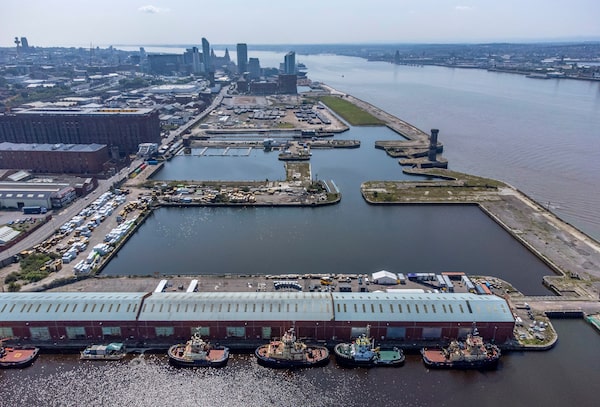
An aerial view of Bramley Moore Dock on Liverpool waterfront, which has been removed from the World Heritage List, on July 21, 2021.Peter Byrne/The Associated Press
Liverpool is best known for the Beatles and its historic port, which was once among the largest in the world and played a pivotal role in expanding the British Empire.
The city gained fresh notoriety last month when UNESCO stripped Liverpool’s famous dockyard of its status as a World Heritage Site because of an $8.7-billion development project that includes office towers, condominiums, shops and a 52,000-seat soccer stadium.
UNESCO said the waterfront complex “was detrimental to the site’s authenticity and integrity” and it violated a conservation plan the city promised to follow in 2004 when it received the heritage designation.
Liverpool officials slammed the decision and said the city had spent roughly $1-billion over the years regenerating the area’s historic character while also improving the lives of people who lived there. “I find it incomprehensible that UNESCO would rather Bramley Moore Dock remain a derelict wasteland, rather than making a positive contribution to the city’s future and that of its residents,” Liverpool Mayor Joanne Anderson told reporters, referring to a key part of the site slated for a new stadium for Everton F.C.
This is only the third time since the adoption of the World Heritage Convention in 1972 that UNESCO has removed a property from its list of more than 1,000 sites – after Dresden’s Elbe Valley in 2009 and the Arabian Oryx Sanctuary in 2007.
The move has raised questions about how historic cities balance heritage protection and economic development. And it has prompted fears that other sites could now be in danger of losing their status, including Stonehenge, where a debate has been raging about a highway tunnel under the ancient stones.
“If the government goes ahead with this huge engineering project, I think [UNESCO] will delete Stonehenge from the World Heritage Site list,” said Barry Joyce, a former vice-chair of the British branch of the International Council on Monuments and Sites, which advises UNESCO.
The UNESCO decision “is a really interesting debate around how you do bring development forward in a way that achieves both conservation and development,” said Henrietta Billings, director of Save Britain’s Heritage, a London-based organization.
Ms. Billings said weak planning rules and a lack of resources have left local authorities unable to protect heritage buildings. Several World Heritage Sites in Britain, such as the Derwent Valley Mills outside Derby, England, have also come under pressure to cede some of their protected area for housing.
“What you need is a coherent masterplan and you need imagination,” Ms. Billings said. She pointed to several cities, such as Bordeaux in France and Hamburg in Germany, that have managed to protect their World Heritage Sites while also encouraging development.
But others say UNESCO has become too rigid and political in its decision making.
“UNESCO is a very strange body. It’s in a parallel universe,” Mr. Joyce said. While the agency draws on top conservation experts from around the world as advisers, final decisions are made by UNESCO ambassadors from member countries who are political appointees. “There’s a lot of horse trading behind the scenes,” he said.
The decision to drop Liverpool was made after a secret ballot of the World Heritage Committee, which consists of representatives from 21 countries. During the committee’s public meeting on July 18 in China, 11 delegates participated in a discussion about Liverpool’s heritage status and only three said they supported dropping it as a World Heritage Site. But when the ballots were later counted, 13 voted in favour of delisting, five voted against and three abstained. The result was one vote above the two-thirds majority needed, of those who voted, to remove a site.
“That’s not the way to make a decision of that sort that has both national and international implications,” said Chris Blandford, president of World Heritage UK, a charity that represents Britain’s 33 World Heritage sites. “And I’m fearful that it won’t have done UNESCO any favours.”
Mr. Blandford said Liverpool had been largely successful in protecting the dockyard and transforming the area into a tourist attraction. “So what is that UNESCO can’t see about that? It’s to do with not willing to compromise,” he said.
He added that UNESCO has evolved from focusing on iconic places such as castles, cathedrals and the Taj Mahal, to including a broader range of cultural heritage properties on its list of World Heritage Sites. Those locations “are by nature more complex and therefore in my view they should have more time” to develop, he said. “And if there’s a controversy like there was in Liverpool, then I sense that there needs to be a little more compromise and balance than there is at the moment.”
Mr. Joyce argued that despite UNESCO’s often flawed decision-making process, the Liverpool case was actually clear-cut. “This didn’t come out of the blue … there have been discussion between UNESCO and the city of Liverpool for over 10 years,” he said.
UNESCO put the site on its danger list in 2012, shortly after city council approved the waterfront project. The agency issued further warnings in subsequent years and concluded the stadium project, which was given the go-ahead this past March, represented “the worst possible approach to new development in this site.”
The waterfront project “was a spectacular and deliberate deviation” from Liverpool’s heritage management plan, Mr. Joyce said. The committee’s decision, he added, “is a warning to other sites to take UNESCO seriously.”
Our Morning Update and Evening Update newsletters are written by Globe editors, giving you a concise summary of the day’s most important headlines. Sign up today.
 Paul Waldie
Paul Waldie